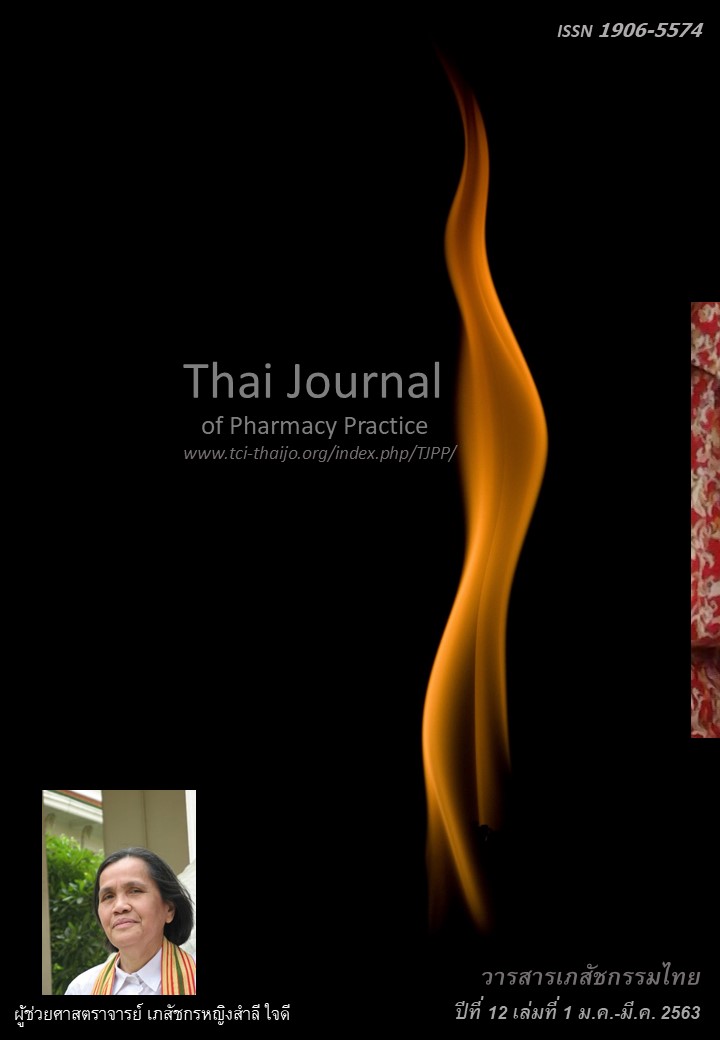ผลของการให้คำแนะนำโดยเภสัชกรในร้านยาเพื่อลดการใช้ยาปฏิชีวนะ อย่างไม่เหมาะสมในผู้ป่วยโรคติดเชื้อทางเดินหายใจส่วนบน
Main Article Content
บทคัดย่อ
วัตถุประสงค์: เพื่อศึกษาผลของการให้คำแนะนำแก่ผู้ป่วยโรคติดเชื้อทางเดินหายใจส่วนบนที่เกิดจากการติดเชื้อไวรัสโดยเภสัชกรในร้านยา วิธีการ: การวิจัยนี้เป็นการศึกษาแบบกลุ่มเดียวที่เก็บข้อมูลไปข้างหน้าในผู้ป่วยที่มารับบริการ ณ ศูนย์ปฏิบัติการเภสัชกรรมชุมชน มหาวิทยาลัยเชียงใหม่ ระหว่างเดือนมีนาคมถึงธันวาคม พ.ศ. 2555 และได้รับการวินิจฉัยว่าเป็นโรคติดเชื้อทางเดินหายใจส่วนบนซึ่งไม่จำเป็นต้องรักษาด้วยยาปฏิชีวนะ ผู้วิจัยใช้ McIsaac score สำหรับประเมินความรุนแรงของโรคและความจำเป็นในการใช้ยาปฏิชีวนะ ผลลัพธ์หลัก คือ สัดส่วนของผู้ป่วยที่ไม่ต้องการใช้ยาปฏิชีวนะภายหลังได้รับคำแนะนำโดยเภสัชกรเกี่ยวกับโรค การใช้ยา การปฏิบัติตนเอง และการใช้ยาปฏิชีวนะอย่างสมเหตุผล โดยใช้แผ่นพลิกและแผ่นพับที่จัดทำขึ้นเป็นสื่อช่วย ผู้ป่วยที่ไม่ใช้ยาปฏิชีวนะได้รับการติดตามผลการรักษาทางโทรศัพท์ในวันที่ 5 หลังการแทรกแซง ผลการวิจัย: ผู้ป่วยทั้งหมด 380 คนเป็นเพศหญิงร้อยละ 58.9 อายุเฉลี่ย 36.9 ปี ผู้ป่วยมีอาการก่อนมารับการรักษาเฉลี่ย 2.3 วัน ส่วนใหญ่มาด้วยอาการเจ็บคอ (ร้อยละ 87.9) ผู้ป่วยมีคะแนนจากการประเมินด้วย McIsaac score อยู่ในช่วง 0 ถึง 3 คะแนน คิดเป็นค่าเฉลี่ย 1.2 ± 0.9 คะแนน ผู้ป่วยจำนวน 240 คน (ร้อยละ 63.2) มีความต้องการใช้ยาปฏิชีวนะ แต่ในจำนวนนี้ 184 คนยินยอมที่จะไม่ใช้ยาปฏิชีวนะภายหลังจากได้รับคำแนะนำจากเภสัชกร ดังนั้นผู้ป่วยทั้งหมด 324 คน (ร้อยละ 85.3) ตัดสินใจไม่เลือกใช้ยาปฏิชีวนะหลังจากได้รับคำแนะนำจากเภสัชกร เภสัชกรสามารถติดตามอาการของผู้ป่วยได้เพียงร้อยละ 21.7 เท่านั้น อย่างไรก็ตามพบว่าผู้ป่วยส่วนใหญ่หายจากโรคภายในระยะเวลา 3.2 ± 1.5 วันหลังได้รับการรักษา สรุป: การให้คำแนะนำโดยเภสัชกรในร้านยา เป็นวิธีหนึ่งที่ทำให้ผู้ป่วยได้ใช้ยาปฏิชีวนะอย่างเหมาะสมกับโรคของผู้ป่วย ซึ่งช่วยลดการดื้อยาของเชื้อและลดค่าใช้จ่ายในการรักษาที่ไม่จำเป็นของผู้ป่วย
Article Details
ผลการวิจัยและความคิดเห็นที่ปรากฏในบทความถือเป็นความคิดเห็นและอยู่ในความรับผิดชอบของผู้นิพนธ์ มิใช่ความเห็นหรือความรับผิดชอบของกองบรรณาธิการ หรือคณะเภสัชศาสตร์ มหาวิทยาลัยสงขลานครินทร์ ทั้งนี้ไม่รวมความผิดพลาดอันเกิดจากการพิมพ์ บทความที่ได้รับการเผยแพร่โดยวารสารเภสัชกรรมไทยถือเป็นสิทธิ์ของวารสารฯ
เอกสารอ้างอิง
2. Shulman ST, Bisno AL, Clegg HW, Gerber MA, Kaplan EL, Lee G, et al. Clinical practice guideline for the diagnosis and management of group A streptococcal pharyngitis: 2012 update by the Infectious Diseases Society of America. Clin Infect Dis. 2012; 55: 1279-82.
3. Franck AJ, Smith RE. Antibiotic use for acute upper respiratory tract infections in a veteran population. J Am Pharm Assoc. 2010; 50: 726-9.
4. Alabid AHMA, Ibrahim MIM, Hassali MA. Antibiotics sispensing for URTIs by community pharmacists and general medical practitioners in Penang, Malaysia: A comparative study using simulated patients. J Clin Diagn Res. 2014; 8: 119–123.
5. Suttajit S, Wagner AK, Tantipidoke R, Ross-Degnan D, Sitthi-amorn C. Patterns, appropriateness, and predictors of antimicrobial prescribing for adults with upper respiratory infections in urban slum communities of Bangkok. Southeast Asian J Trop Med Public Health. 2005; 36: 489-97.
6. Treebupachatsakul P, Tiengrim S, Thamlikitkul V. Upper respiratory tract infection in Thai adults: prevalence and prediction of bacterial causes, and effectiveness of using clinical practice guidelines. J Med Assoc Thai. 2006; 89: 1178-86.
7. Essack S, Bell J, Shephard A. Community pharmacists - leaders for antibiotic stewardship in respiratory tract infection. J Clin Pharm Ther. 2018 ;43: 302-7.
8. Sumpradit N, Chongtrakul P, Anuwong K, Pumtong S, Kongsomboon K, Butdeemee P, et al. Antibiotics smart use: a workable model for promoting the rational use of medicines in Thailand. Bull World Health Organ. 2012; 90: 905-13.
9. Chongtrakul P. RDU hospital: the pathway to rational drug use. Thai J Pharmacol. 2015; 37: 48-62.
10. Chantrapipat K, Fongthong T, Saokaew S. Effective ness of the National Health Security Office ‘s policy to promote rational use of antibiotics by using payment for quality performance. Thai Journal of Pharmacy Practice. 2017; 9:499-515.
11. Boonyasiri A, Thamlikitkul V. Effectiveness of multifaceted interventions on rational use of antibiotics for patients with upper respiratory tract infections and acute diarrhea. J Med Assoc Thai 2014; 97:13-19.
12. Phaliphot V, Chittawattanarat K, Ruengorn C, Lucksiri A. Effects of antibiotic restriction program in critical care surgery patients at Maharaj Nakorn Chiang Mai Hospital. Thai Pharm Health Sci J. 2015 ; 10: 59-66.
13. Ananwattanakit M, Usayaporn S, Tantawichien T, Puttilerpong C, Pengsuparp T. Effects of pharma- cist participation in an antimicrobial stewardship program on appropriate antibiotic use. Thai Pharm Health Sci J. 2015; 10: 1-9.
14. Saengcharoen W, Chongsuvivatwong V, Lerkiatbun- dit S, Wongpoowarak P. Factors influencing dispen- sing of antibiotics for upper respiratory infections among southern Thai community pharmacists. J Clin Pharm Ther. 2008; 33: 123-9.
15. McIsaac WJ, Kellner JD, Aufricht P, Vanjaka A, Low DE.Empirical validation of guidelines for the mana- gement of pharyngitis in children and adults. JAMA. 2004; 291: 1587-95.
16. Yamane, T. Statistics: an introductory analysis. 2nd ed. New York: Harper Press; 1967.
17. Uruekoran R, Phonsena W, Thongdang S, Somsa ard P, Chaiyasong S, Srisilp T. Treatment outcome and cost of rationale antibiotic use implementation in Mahasarakham University pharmacy. Isan Journal of Pharmaceutical Science. 2013;9: 31-42.


